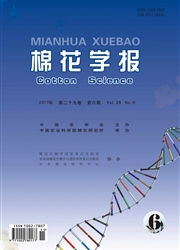

 中文摘要:
中文摘要:
抗源52—128、57—681是我国第一批高抗枯萎病的抗源种质,为了确立抗源种质转育应用的理论支撑,丰富棉花抗性育种的遗传理论,对两个抗源种质的抗性遗传特性进行了研究。试验在所内人工接菌水泥槽病床和大田接菌病圃中,采用不完全双列杂交试验方法,研究两个抗源经多年病圃和无病地连续种植后的抗性变异和遗传效应。结果表明,抗源种质52—128、57—681的抗性多年、多代一直保持稳定,且抗性遗传效应好、遗传力高,转育利用价值大,为我国利用两个抗源奠定了基础。全国利用两个抗源转育出了一大批通过审定的棉花抗病品种应用于生产。
 英文摘要:
英文摘要:
Fusariurn wilt is one of the important soil-borne diseases in cotton which could not be controlled effectively with chemicals. It had been proved that breeding and growing resistant cultivars is one of the economical and effective measures to control this disease, and resistant resources are the basis for cotton disease resistant breeding. 52-128 and 57-681 are the first cotton resistant resources bred in China. Both are highly resistant to Fusariurn wilt. The objective of this paper is to reveal the genetics and to promote the utilization of these resistant resources. The resistance genetics of the two resources was studied employing incomplete diallele cross in artificial inoculating nursery. It was shown that 52-128 and 57-681 remained high resistance continuously after growing and selecting through artificial inoculating nursery year by year, and the two resources possessed better genetics effect of resistance as well. It helped to the utilization of the two resources and numbers of resistant cotton cultivars were gained with the two resources used.
 同期刊论文项目
同期刊论文项目
 同项目期刊论文
同项目期刊论文
 期刊信息
期刊信息
